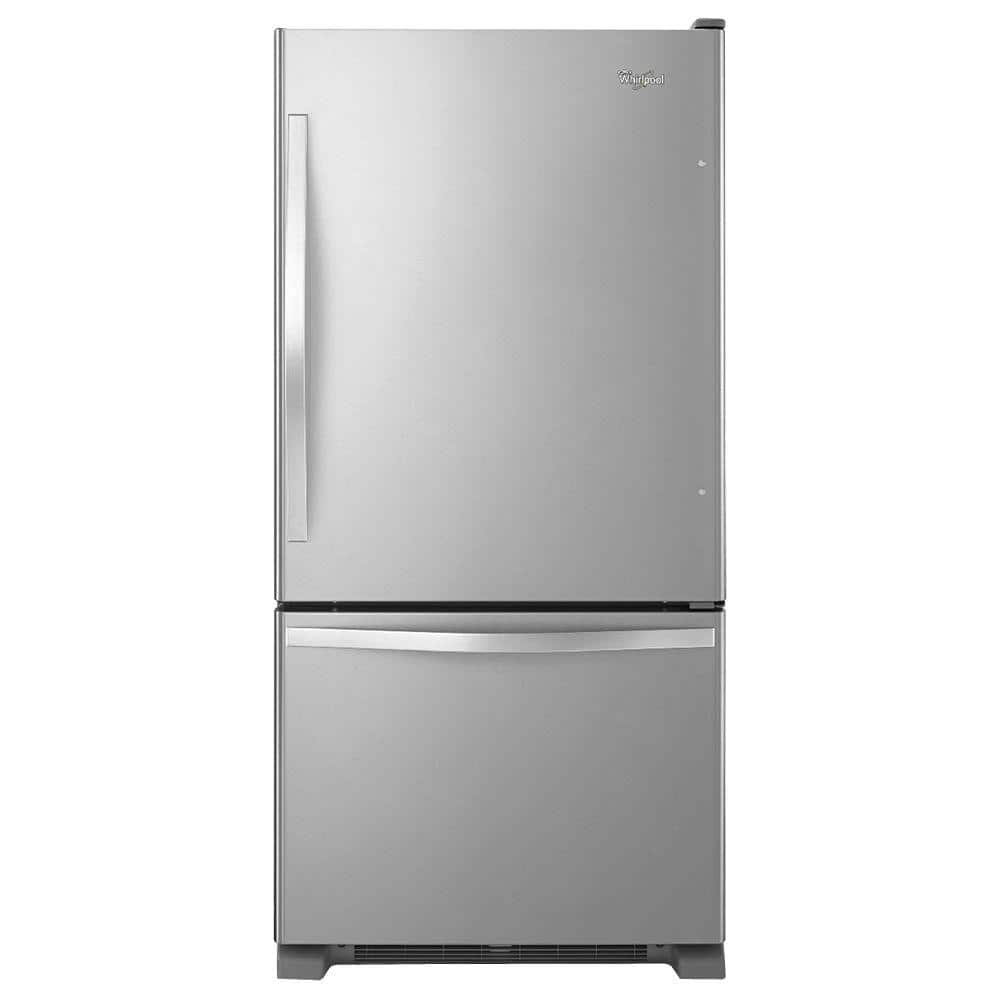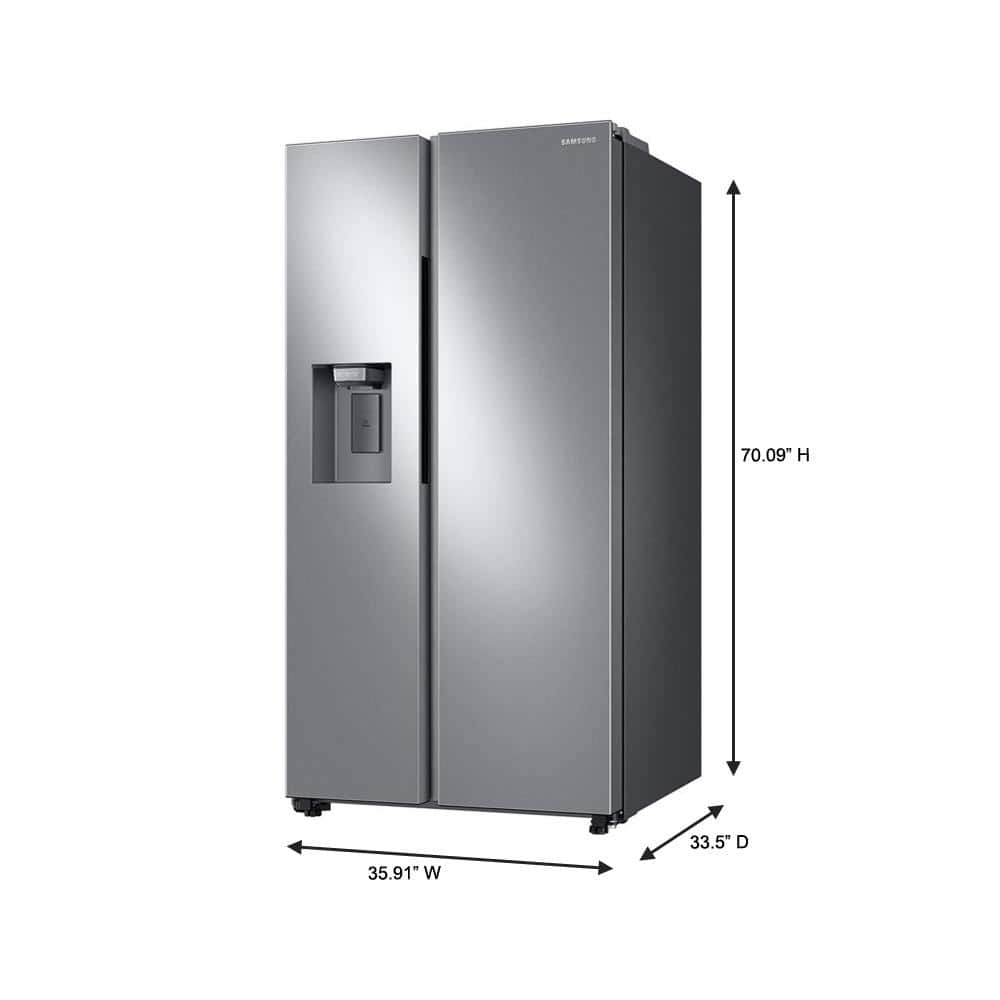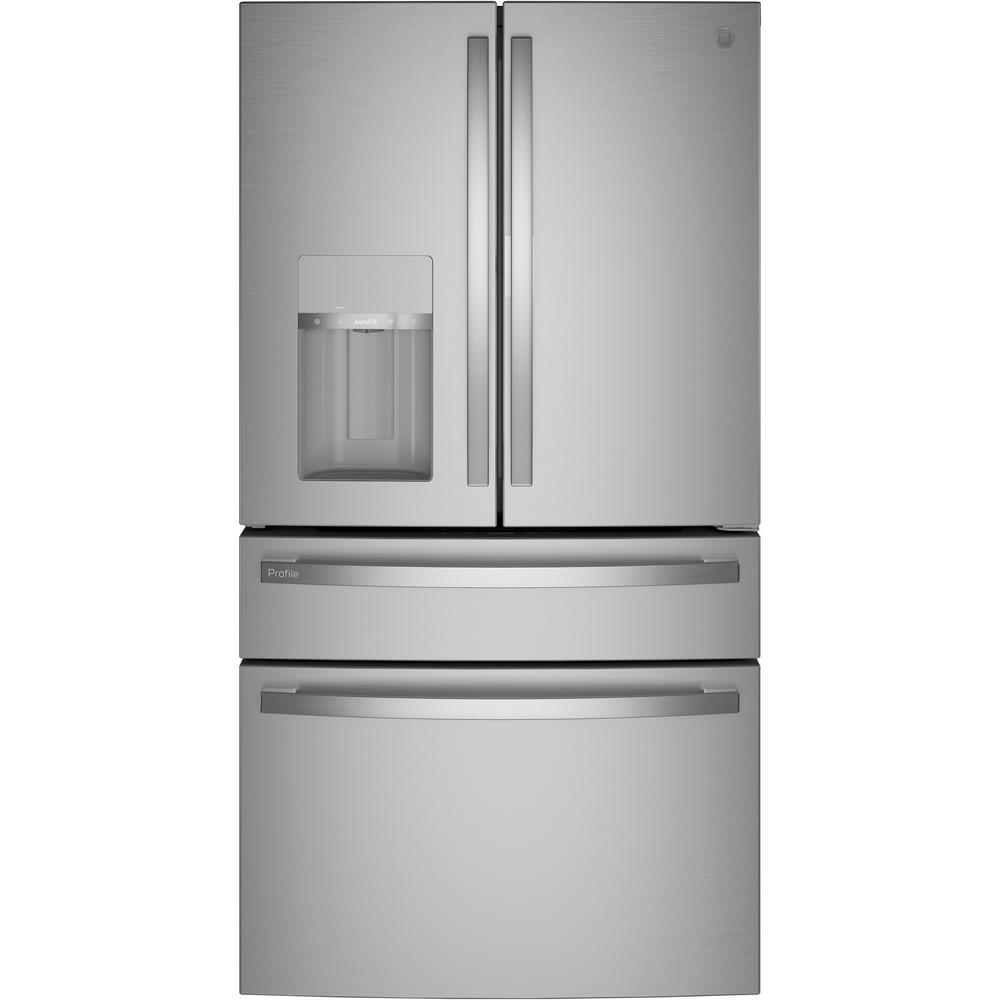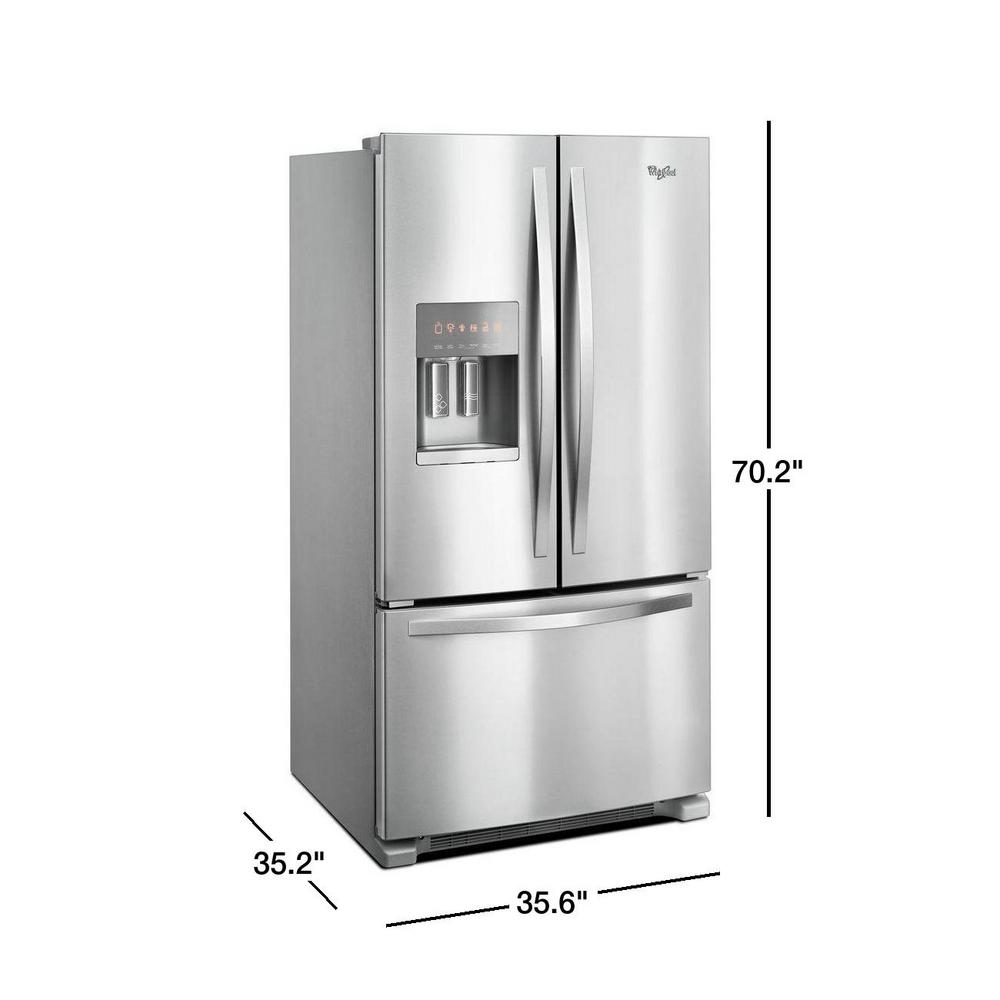Whirlpool 22 cu. ft. Bottom Freezer Refrigerator in Stainless Steel with Spill Guard Glass Shelves
-
( 6 Reviews )Rated 4.83 out of 5 based on 6 customer ratings06
LED lighting makes it easy to see fresh and frozen food. SPILLGUARD glass shelves help contain leaks for easy cleanup. Cool food quickly with this model’s temperature management system.
Storing all of your favorite fresh and frozen foods is easy with this Whirlpool 22.1 cu. ft. bottom-freezer refrigerator. It has a convenient freezer drawer that places frozen items in close reach, making it easy to organize and find exactly what you need. You’ll be able to keep food at the right temperature without wasting energy thanks to the Accu-Chill temperature management system. It monitors internal temperature and activates the compressor only when necessary. And your food will be easy to see thanks to with energy-efficient LED lights, which cast a bright, natural looking light. And you can enjoy having a refrigerator with all of these great features even more knowing it has been designed, engineered and assembled in the U.S.A.
- ENERGY STAR-qualified and CEE Tier I rated. Designed to conserve natural resources and help save you money on utility bills, this eco-friendly refrigerator is better for the environment and your wallet
- Factory installed ice maker provides fresh ice conveniently
- Electronic temperature controls located inside the refrigerator make it simple to monitor and change the refrigerator and freezer temperatures
- Accu-Chill Temperature Management System. Save energy and cool your food quickly. This intuitive system senses and adapts – activating the compressor only when necessary, to deliver efficient cooling performance while saving energy
- SpillGuard glass shelves contain spills and simplify cleanup
- Humidity-controlled crispers help preserve the freshness of fruits and vegetables
- Adjustable refrigerator compartment door bins and stationary gallon-size door shelf provide flexible storage options
- 15.62 cu. ft. fresh food compartment and 6.45 cu. ft. freezer compartment provide spacious storage options
- Freezer drawer. Easily organize and access frozen items with the convenient freezer drawer
- FreshFlow produce preserver helps to extend the freshness of produce. Its filter absorbs excess ethylene gas that causes some produce, such as lettuce and cantaloupe, to spoil
- Built with American pride and designed, engineered and assembled in the U.S.A.
- LED lighting makes it easy to see fresh and frozen food. It puts a spotlight on food and casts a bright, natural-looking light on the contents
- 2 door bottom freezer refrigerator: 1 refrigerator compartment door and 1 freezer compartment drawer
- Reversible door swing allows you to switch the refrigerator door to open from either side
Additional information
| Depth (Excluding Handles) (In) | 30.88 |
|---|---|
| Depth (Including Handles) (In) | 33.38 |
| Depth (Less Door) (In) | 28.13 |
| Depth With Door Open 90 Degrees (In) | 62 |
| Height to Top of Door Hinge (in.) | 70 |
| Height to Top of Refrigerator (in.) | 68.5 |
| Product Depth (in.) | 33.38 |
| Product Height (in.) | 70 |
| Product Width (in.) | 32.63 |
| Refrigerator Width (In.) | 32.75 |
| Certifications and Listings | UL Listed |
| Manufacturer Warranty | 1 Year Limited |
Glass is an amorphous (non-crystalline) solid. Because it is often transparent and chemically inert, glass has found widespread practical, technological, and decorative use in window panes, tableware, and optics. Some common objects made of glass are named after the material, e.g., a "glass" for drinking, "glasses" for vision correction, and a "magnifying glass".
Glass is most often formed by rapid cooling (quenching) of the molten form. Some glasses such as volcanic glass are naturally occurring, and obsidian has been used to make arrowheads and knives since the Stone Age. Archaeological evidence suggests glassmaking dates back to at least 3600 BC in Mesopotamia, Egypt, or Syria. The earliest known glass objects were beads, perhaps created accidentally during metalworking or the production of faience, which is a form of pottery using lead glazes.
Due to its ease of formability into any shape, glass has been traditionally used for vessels, such as bowls, vases, bottles, jars and drinking glasses. Soda–lime glass, containing around 70% silica, accounts for around 90% of modern manufactured glass. Glass can be coloured by adding metal salts or painted and printed with vitreous enamels, leading to its use in stained glass windows and other glass art objects.
The refractive, reflective and transmission properties of glass make glass suitable for manufacturing optical lenses, prisms, and optoelectronics materials. Extruded glass fibres have applications as optical fibres in communications networks, thermal insulating material when matted as glass wool to trap air, or in glass-fibre reinforced plastic (fibreglass).
A refrigerator, commonly shortened to fridge, is a commercial and home appliance consisting of a thermally insulated compartment and a heat pump (mechanical, electronic or chemical) that transfers heat from its inside to its external environment so that its inside is cooled to a temperature below the room temperature. Refrigeration is an essential food storage technique around the world. The low temperature reduces the reproduction rate of bacteria, so the refrigerator lowers the rate of spoilage. A refrigerator maintains a temperature a few degrees above the freezing point of water. The optimal temperature range for perishable food storage is 3 to 5 °C (37 to 41 °F). A freezer is a specialized refrigerator, or portion of a refrigerator, that maintains its contents’ temperature below the freezing point of water. The refrigerator replaced the icebox, which had been a common household appliance for almost a century and a half. The United States Food and Drug Administration recommends that the refrigerator be kept at or below 4 °C (40 °F) and that the freezer be regulated at −18 °C (0 °F).
The first cooling systems for food involved ice. Artificial refrigeration began in the mid-1750s, and developed in the early 1800s. In 1834, the first working vapor-compression refrigeration system, using the same technology seen in air conditioners, was built. The first commercial ice-making machine was invented in 1854. In 1913, refrigerators for home use were invented. In 1923 Frigidaire introduced the first self-contained unit. The introduction of Freon in the 1920s expanded the refrigerator market during the 1930s. Home freezers as separate compartments (larger than necessary just for ice cubes) were introduced in 1940. Frozen foods, previously a luxury item, became commonplace.
Freezer units are used in households as well as in industry and commerce. Commercial refrigerator and freezer units were in use for almost 40 years prior to the common home models. The freezer-over-refrigerator style had been the basic style since the 1940s, until modern, side-by-side refrigerators broke the trend. A vapor compression cycle is used in most household refrigerators, refrigerator–freezers and freezers. Newer refrigerators may include automatic defrosting, chilled water, and ice from a dispenser in the door.
Domestic refrigerators and freezers for food storage are made in a range of sizes. Among the smallest are Peltier-type refrigerators designed to chill beverages. A large domestic refrigerator stands as tall as a person and may be about one metre (3 ft 3 in) wide with a capacity of 0.6 m3 (21 cu ft). Refrigerators and freezers may be free standing, or built into a kitchen. The refrigerator allows the modern household to keep food fresh for longer than before. Freezers allow people to buy perishable food in bulk and eat it at leisure, and make bulk purchases.
A spill occurs when the contents of something, usually in liquid form, are emptied out onto a surface, person or clothes, often unintentionally.
Spill may also refer to:
- Oil spill
- Chemical spill
- Data spill
- Leadership spill
- Spill (audio), where audio from one source is picked up by a microphone intended for a different source
- Variable spilling, a side effect of register allocation
- Thin sticks of wood or tightly rolled paper tapers, used for transferring fire, and stored in a spill vase
- SPILL – an acronym for St Pancras International Low Level, the Thameslink platforms at St Pancras railway station in London
Stainless may refer to:
- Cleanliness, or the quality of being clean
- Stainless steel, a corrosion-resistant metal alloy
- Stainless Games, a British video game developer
- Stainless Broadcasting Company, a TV broadcaster based in Michigan, US
- Stainless Banner, the second national flag of the Confederate States of America
Steel is an alloy of iron and carbon with improved strength and fracture resistance compared to other forms of iron. Because of its high tensile strength and low cost, steel is one of the most commonly manufactured materials in the world. Steel is used in buildings, as concrete reinforcing rods, in bridges, infrastructure, tools, ships, trains, cars, bicycles, machines, electrical appliances, furniture, and weapons.
Iron is always the main element in steel, but many other elements may be present or added. Stainless steels, which are resistant to corrosion and oxidation, typically are 18% chromium.
Iron is the base metal of steel. Depending on the temperature, it can take two crystalline forms (allotropic forms): body-centred cubic and face-centred cubic. The interaction of the allotropes of iron with the alloying elements, primarily carbon, gives steel and cast iron their range of unique properties. In pure iron, the crystal structure has relatively little resistance to the iron atoms slipping past one another, and so pure iron is quite ductile, or soft and easily formed. In steel, small amounts of carbon, other elements, and inclusions within the iron act as hardening agents that prevent the movement of dislocations.
The carbon in typical steel alloys may contribute up to 2.14% of its weight. Varying the amount of carbon and many other alloying elements, as well as controlling their chemical and physical makeup in the final steel (either as solute elements, or as precipitated phases), impedes the movement of the dislocations that make pure iron ductile, and thus controls and enhances its qualities. These qualities include the hardness, quenching behaviour, need for annealing, tempering behaviour, yield strength, and tensile strength of the resulting steel. The increase in steel's strength compared to pure iron is possible only by reducing iron's ductility.
Steel was produced in bloomery furnaces for thousands of years, but its large-scale, industrial use began only after more efficient production methods were devised in the 17th century, with the introduction of the blast furnace and production of crucible steel. This was followed by the Bessemer process in England in the mid-19th century, and then by the open-hearth furnace. With the invention of the Bessemer process, a new era of mass-produced steel began. Mild steel replaced wrought iron. The German states were the major steel producers in Europe in the 19th century. American steel production was centred in Pittsburgh; Bethlehem, Pennsylvania; and Cleveland until the late 20th century. Currently, world steel production is centered in China, which produced 54% of the world's steel in 2023.
Further refinements in the process, such as basic oxygen steelmaking (BOS), largely replaced earlier methods by further lowering the cost of production and increasing the quality of the final product. Today more than 1.6 billion tons of steel is produced annually. Modern steel is generally identified by various grades defined by assorted standards organizations. The modern steel industry is one of the largest manufacturing industries in the world, but also one of the most energy and greenhouse gas emission intense industries, contributing 8% of global emissions. However, steel is also very reusable: it is one of the world's most-recycled materials, with a recycling rate of over 60% globally.
A whirlpool is a body of rotating water produced by opposing currents or a current running into an obstacle. Small whirlpools form when a bath or a sink is draining. More powerful ones formed in seas or oceans may be called maelstroms ( MAYL-strom, -strəm). Vortex is the proper term for a whirlpool that has a downdraft.
In narrow ocean straits with fast flowing water, whirlpools are often caused by tides. Many stories tell of ships being sucked into a maelstrom, although only smaller craft are actually in danger. Smaller whirlpools appear at river rapids and can be observed downstream of artificial structures such as weirs and dams. Large cataracts, such as Niagara Falls, produce strong whirlpools.
With or WITH may refer to:
- With, a preposition in English
- Carl Johannes With (1877–1923), Danish doctor and arachnologist
- With (character), a character in D. N. Angel
- With (novel), a novel by Donald Harrington
- With (album), a 2014 album by TVXQ
- With (EP), a 2021 EP by Nam Woo-hyun






by Gail
Love the size and space of both fridge and freezer
by Butch
[This review was collected as part of a promotion.] Love the refrigerator. Just the right size. But, we cant make it stop rolling forward every time we open it.
by Chris
Yes , excellent machine , very pleased ! I’ll look at whirlpool next time and I don’t do photos !
by Steve
Happy with purchase. No issues with this refrigerator.
by Jay
It keeps things cold an keeps the appropriate area frozen.
by Ulises
Generally good and quite refrigerator, but assembly quality leaves much to be desired (gaps between parts and isolation foam all over)